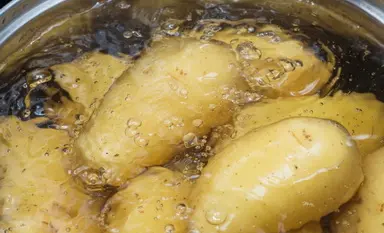The right way to cook potatoes
Your mum or dad may have taught you this when you were a child: You take a small sharp knife and try to get through the cooked potato, if you can do it easily, it's cooked. It always works of course, but it's a bit subjective, "easily" is not very easy to appreciate and then it depends on the variety of the potato, "Rattes" for example are much firmer than the "Belles de Fontenay".
Can you do any better than cutting through them with a knife?
Yes, and it's quite simple, let's imagine you want to make melting potatoes, and therefore be sure they are well cooked, then in that case, stick the famous knife in the potato, vertically, and lift the potato.
It comes with the knife? => undercooked, continue cooking
Does it fall off the knife by itself, or does the knife come out by itself? => they are cooked!
Obviously this only works with good sized potatoes, with grits or rattes it's wrong, the weight is too low for them to fall back...
In summary: To test the cooking of a potato, stick a knife vertically into it and lift it up, if the potato stays in place or falls back on its own after a few seconds, it is well cooked.

Can you do any better than cutting through them with a knife?
Yes, and it's quite simple, let's imagine you want to make melting potatoes, and therefore be sure they are well cooked, then in that case, stick the famous knife in the potato, vertically, and lift the potato.
It comes with the knife? => undercooked, continue cooking
Does it fall off the knife by itself, or does the knife come out by itself? => they are cooked!

Obviously this only works with good sized potatoes, with grits or rattes it's wrong, the weight is too low for them to fall back...
In summary: To test the cooking of a potato, stick a knife vertically into it and lift it up, if the potato stays in place or falls back on its own after a few seconds, it is well cooked.
Lasts posts
Butter vs. grease
We often read in a recipe where a pastry is put into a mould that, just before pouring, the mould should be buttered or greased. But what's the difference between these 2 terms?December 1st 20251,4155
Getting out of the fridge early
Very often when you're cooking, you need to take food or preparations out of the fridge, to use them in the recipe in progress. There's nothing tricky about this: you just take them out of the fridge and use them, usually immediately, in the recipe. But is this really a good method?November 24th 20251,2715
Who's making the croissants?
When you look at a bakery from the outside, you naturally think that in the bakery, the bakers make the bread, and in the laboratory, the pastry chefs make the cakes. It's very often like that, with each of these professions having quite different ways of working, but sometimes there's also one...November 23th 20251,162
Oven height
When we put a dish or cake in the oven, we naturally tend to put it on the middle shelf, and that's what we usually do. But in some cases, this position and height can be a little tricky, so let's find out why.October 8th 20253,2495
The importance of sieving
In recipes that use a fine powder (flour, powdered sugar, etc.), you'll often see the advice to sift before using it. To sift is to pass the powder in question through a sieve (a very fine strainer) before incorporating it into your recipe. It's often advice, but is it really useful?September 3rd 20257,8853
Other pages you may also like
What is the difference between bakery and patisserie?
This is a question that you may well have asked yourself and which I will attempt to answer. In France the two trades of "boulangerie" (bakery) and "pâtisserie" (patisserie and confectionery) have always been quite distinct, but where exactly do the boundaries lie? .February 7th 2017134 K 14.1
Candied fruits: don't get ripped off
Do you like candied fruit? You might like to nibble a handful or add it to a recipe, like a classic fruit cake or delicious Italian specialities like panettone or sicilian epiphany pie.June 21th 201768 K 24.2
85 grams of eggs?
Some time ago, I already spoke to you about the difference between baking and pastry-making, I emphasized, among other things, the precision of pastry-making which requires grams, cm, degrees and minutes. That's why, on the one hand, you have baking and cooking, where a certain tolerance is...November 26th 201857 K4.6
Cooking time for pasta
What is as good and simple as pasta? Not much, I think, and it's so easy to prepare: boiling water, salted (or not, depending on your taste), a few minutes of boiling and it's ready. The only "difficulty", so to speak, is the respect of the cooking time and the risk of, unfortunately, overcooking...July 18th 201924 K4.6
Cleaning endives
If you buy your endives elsewhere than in supermarkets, and in this case the best is of course from a market gardener, he or she is the one who planted and harvested them, in this case you will have endives full of earth or sand, depending on where they were grown, which is normal and reassuring, we...March 24th 202026 K4.6
Post a comment or question
Follow this page
If you are interested in this page, you can "follow" it, by entering your email address here. You will then receive a notification immediately each time the page is modified or a new comment is added. Please note that you will need to confirm this following.
Note: We'll never share your e-mail address with anyone else.
Alternatively: you can subscribe to the mailing list of cooling-ez.com , you will receive a e-mail for each new recipe published on the site.









